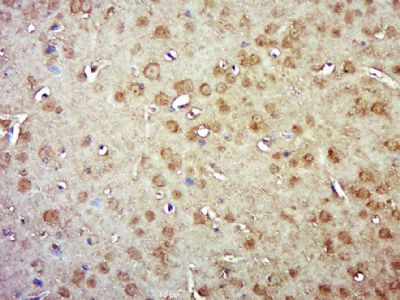SMG1 Polyclonal Antibody
Purified Rabbit Polyclonal Antibody (Pab)
- SPECIFICATION
- CITATIONS
- PROTOCOLS
- BACKGROUND

Application
| IHC-P, IHC-F, IF, ICC, E |
|---|---|
| Primary Accession | Q96Q15 |
| Reactivity | Dog, Bovine |
| Host | Rabbit |
| Clonality | Polyclonal |
| Calculated MW | 410 KDa |
| Physical State | Liquid |
| Immunogen | KLH conjugated synthetic peptide derived from human SMG1 |
| Epitope Specificity | 3551-3661/3661 |
| Isotype | IgG |
| Purity | affinity purified by Protein A |
| Buffer | 0.01M TBS (pH7.4) with 1% BSA, 0.02% Proclin300 and 50% Glycerol. |
| SUBCELLULAR LOCATION | Nuclear. Cytoplasm. |
| SIMILARITY | Belongs to the PI3/PI4-kinase family. Contains 1 FAT domain. Contains 1 FATC domain. Contains 1 HEAT repeat. Contains 1 PI3K/PI4K domain. |
| SUBUNIT | Component of the SMG1C complex composed of SMG1, SMG8 and SMG9; the recruitment of SMG8 to SMG1 N-terminus induces a large conformational change in the SMG1 C-terminal head domain containing the catalytic domain. Component of the transient SURF (SMG1-UPF1-eRF1-eRF3) complex. Interacts with PRKCI. Interacts with TELO2 and TTI1. Interacts with RUVBL1 and RUVBL2. Interacts with UPF2. |
| Post-translational modifications | utophosphorylated. |
| Important Note | This product as supplied is intended for research use only, not for use in human, therapeutic or diagnostic applications. |
| Background Descriptions | This gene encodes a protein involved in nonsense-mediated mRNA decay (NMD) as part of the mRNA surveillance complex. The protein has kinase activity and is thought to function in NMD by phosphorylating the regulator of nonsense transcripts 1 protein. Alternatively spliced transcript variants have been described, but their full-length nature has yet to be determined. [provided by RefSeq, Mar 2013] |
| Gene ID | 23049 |
|---|---|
| Other Names | Serine/threonine-protein kinase SMG1, SMG-1, hSMG-1, 2.7.11.1, 61E3.4, Lambda/iota protein kinase C-interacting protein, Lambda-interacting protein, SMG1, ATX, KIAA0421, LIP |
| Target/Specificity | Widely expressed, with highest level in heart and skeletal muscle. Expressed in placenta, brain, lung and spleen, but not in liver. |
| Dilution | IHC-P=1:100-500,IHC-F=1:100-500,ICC=1:100-500,IF=1:100-500,ELISA=1:5000-10000 |
| Storage | Store at -20 ℃ for one year. Avoid repeated freeze/thaw cycles. When reconstituted in sterile pH 7.4 0.01M PBS or diluent of antibody the antibody is stable for at least two weeks at 2-4 ℃. |
| Name | SMG1 (HGNC:30045) |
|---|---|
| Function | Serine/threonine protein kinase involved in both mRNA surveillance and genotoxic stress response pathways. Recognizes the substrate consensus sequence [ST]-Q. Plays a central role in nonsense- mediated decay (NMD) of mRNAs containing premature stop codons by phosphorylating UPF1/RENT1. Recruited by release factors to stalled ribosomes together with SMG8 and SMG9 (forming the SMG1C protein kinase complex), and UPF1 to form the transient SURF (SMG1-UPF1-eRF1-eRF3) complex. In EJC-dependent NMD, the SURF complex associates with the exon junction complex (EJC) through UPF2 and allows the formation of an UPF1-UPF2-UPF3 surveillance complex which is believed to activate NMD. Also acts as a genotoxic stress-activated protein kinase that displays some functional overlap with ATM. Can phosphorylate p53/TP53 and is required for optimal p53/TP53 activation after cellular exposure to genotoxic stress. Its depletion leads to spontaneous DNA damage and increased sensitivity to ionizing radiation (IR). May activate PRKCI but not PRKCZ. |
| Cellular Location | Nucleus. Cytoplasm. Note=Present in the chromatoid body {ECO:0000250|UniProtKB:Q8BKX6} |
| Tissue Location | Widely expressed, with highest level in heart and skeletal muscle. Expressed in placenta, brain, lung and spleen, but not in liver. |

Thousands of laboratories across the world have published research that depended on the performance of antibodies from Abcepta to advance their research. Check out links to articles that cite our products in major peer-reviewed journals, organized by research category.
info@abcepta.com, and receive a free "I Love Antibodies" mug.
Provided below are standard protocols that you may find useful for product applications.
If you have used an Abcepta product and would like to share how it has performed, please click on the "Submit Review" button and provide the requested information. Our staff will examine and post your review and contact you if needed.
If you have any additional inquiries please email technical services at tech@abcepta.com.













 Foundational characteristics of cancer include proliferation, angiogenesis, migration, evasion of apoptosis, and cellular immortality. Find key markers for these cellular processes and antibodies to detect them.
Foundational characteristics of cancer include proliferation, angiogenesis, migration, evasion of apoptosis, and cellular immortality. Find key markers for these cellular processes and antibodies to detect them. The SUMOplot™ Analysis Program predicts and scores sumoylation sites in your protein. SUMOylation is a post-translational modification involved in various cellular processes, such as nuclear-cytosolic transport, transcriptional regulation, apoptosis, protein stability, response to stress, and progression through the cell cycle.
The SUMOplot™ Analysis Program predicts and scores sumoylation sites in your protein. SUMOylation is a post-translational modification involved in various cellular processes, such as nuclear-cytosolic transport, transcriptional regulation, apoptosis, protein stability, response to stress, and progression through the cell cycle. The Autophagy Receptor Motif Plotter predicts and scores autophagy receptor binding sites in your protein. Identifying proteins connected to this pathway is critical to understanding the role of autophagy in physiological as well as pathological processes such as development, differentiation, neurodegenerative diseases, stress, infection, and cancer.
The Autophagy Receptor Motif Plotter predicts and scores autophagy receptor binding sites in your protein. Identifying proteins connected to this pathway is critical to understanding the role of autophagy in physiological as well as pathological processes such as development, differentiation, neurodegenerative diseases, stress, infection, and cancer.


